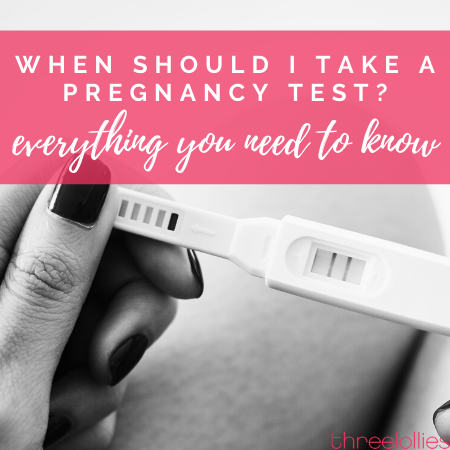When To Take a Pregnancy Test

June 30th, 2020 | Blog, Pregnancy
Whether you’ve been patiently counting down the days of your two-week-wait, or unexpectedly find yourself wondering if you could be pregnant, you’re probably wondering, when should I take a pregnancy test?
There’s actually a lot to unpack when it comes to pregnancy tests! Things like, what time of day should you take a pregnancy test? Can you take a pregnancy test before your missed period? False positives, homemade pregnancy tests, the list goes on and on!
And when all of this rides on whether or not a tiny baby is growing in your belly, you want to know as soon as possible. As a mama of two, I am no stranger to the two-week wait. It can feel like an eternity between when you ovulate and when those two little lines show up!
Today we’re going to clear up all of your pregnancy test-related questions in this one-stop guide.
When should I take a pregnancy test?
In short, the best time to take a pregnancy test is on the day of your missed period or any day after your missed period. In fact, at this point, home pregnancy tests are over 99% accurate on or after your missed period! This is because if you are pregnant, there will be enough hCG present in your body to trigger a positive test result.
But, if you are hoping to test early, or want to understand the why a little more, here are a few important things to understand:
- Pregnancy tests work by measuring the pregnancy hormone hCG in urine. So, the timing for your pregnancy test is dependent on the presence of this hormone
- Your body begins to produce hCG very soon after the implantation of the fertilized egg in your uterus. However, implantation can take anywhere from 3 to 12 days after ovulation meaning there is a wide range of what to expect
- Once implantation has occurred, the amount of hCG in your urine typically doubles every two days. With this in mind, the closer you get to your expected (or missed!) period, the more hCG will be present in your urine, and the more likely you will get an accurate test result
- Most tests on the market are designed to pick up hCG levels between 20-35 mIU/ml. Tests designed to give an “early result” typically fall on the lower end of that range
- The earliest that amount of hCG could be in your urine is likely 8 days past ovulation. Keep in mind this is not a guarantee! (source)
- To give you an example, the First Response Early Result Pregnancy Test states that their tests are 76% accurate 5 days before a missed period, 96% accurate four days before a missed period, and over 99% accurate 3 or less days before (or after) your missed period (source)
What Time of Day Should You Take a Pregnancy Test?
The best time of day to take a pregnancy test is first thing in the morning. This is especially true if you are testing early. The idea is that your urine is typically more concentrated in the morning and will have a higher level of hCG present.
If you are testing after your missed period, it’s still best to test first thing in the morning to ensure you don’t get a false negative, but you will likely get a positive result no matter what time of day you test.
What pregnancy test should I take?
Now that you know when to take a pregnancy test, let’s figure out which kind of pregnancy test you should take. A quick walk down the family planning aisle at your local store will show you that there are a ton of options at a ton of different price points!
Are the more expensive tests automatically better? What about those infamous 88 cent Walmart pregnancy tests? Do they work? Pregnancy tests typically fall into one of three categories: pink dye, blue dye, or digital, like Clear Blue pregnancy tests. Here’s the low down.
Pink Dye Pregnancy Tests
These pregnancy tests work when a chemical reaction causes a line to appear when a certain amount of hCG is present. Pink dye tests are considered a superior option to blue dye to most mamas because they do not show evaporation lines (which can be misread as a false positive). What’s more, pink dye tests often have more sensitive detection thresholds (though not always).
Blue Dye Pregnancy Tests
These tests work in the same manner as pink dye tests but are notorious for displaying prominent evaporation lines which can be read as a false positive. This can make it confusing to tell if your test is actually positive. Often blue dye tests are less expensive (but again, not always).
Digital Pregnancy Tests
Digital pregnancy tests are the easiest to read. They give a very clear pregnant or not pregnant. However, these types of tests are usually less sensitive than dye tests, and its recommended to only use them on the day of your expected period or after your missed period. Digital pregnancy tests are often the most expensive option
Do cheap pregnancy tests work?
Absolutely! Inexpensive options, like the Walmart pregnancy test or Dollar Tree pregnancy test, are just as accurate as their more expensive counterparts. And like with all tests, this is especially true when you are taking a test on or after the day of your missed period.
The huge benefit of these tests is their low cost and accuracy. If you are someone who likes to test frequently leading up to your missed period (you know who you are ???? ) these are an especially good option.
On the flip side, because these tests are less expensive, they are a little less convenient. For this type of test, you will need to pee into a clean cup or container and use the included dropper to dispense urine onto the test. This makes them a little more involved than more expensive options where you pee directly onto the test and put on a cap.
First Signal Walmart Pregnancy Test
At just 88 cents, these pregnancy tests are the least expensive option available and are highly accurate.
Dollar Tree Pregnancy Test
Dollar Tree pregnancy tests are very popular and for good reason! When tested for sensitivity, they were found to show a positive result at just 25 mIU/mL, which is on the most sensitive range of all pregnancy tests on the market. It’s also the sensitivity of most urine pregnancy tests used in clinical settings (source).
What about homemade pregnancy tests?
Homemade pregnancy tests can be a lot of fun to try, but most experts don’t recommend relying on a DIY option to verify your pregnancy. Most homemade options involve things you can find in your home, like toothpaste, vinegar, or cleaning agents. The idea is that if your urine has hCG in it when your urine reacts with the agent, the effect will be different than urine that does not contain hCG.
Here are three common homemade pregnancy test ideas (source):
- Toothpaste: Add urine to two tablespoons of white toothpaste, if the toothpaste turns blue or starts to foam its considered a positive result
- Vinegar: Add urine to a bowl of white vinegar, if there is a color change after three to five minutes it’s a positive result
- Sugar: Add urine to a few teaspoons of white sugar. If the sugar clumps together (and does not dissolve) it’s a positive result
If you decide to try a homemade pregnancy test, there’s really no harm done. Most are totally safe and fun to try, but don’t put too much stock in the results––a store bought test is the way to go.
Here’s to your big fat positive!
Now you know when to take your pregnancy test and you have a better idea of which test to take. Remember that it’s always best to follow the directions that come with your test kit. It’s especially important to read your test results within the recommended time frame to avoid misreading an evaporation line as a false positive.
Aim to take your test first thing in the morning, and try your best to test on or after the day of your expected period for the most accurate results. Keeping my finger crossed for you, mama!
By: Alli Wittbold
Recent Posts
- Vegan and Vegetarian Nausea Relief: Best Plant-Based Remedies and Tips for 2025
- Essential Packing List for Pregnant Travelers 2025 | Comfort, Health & Safety Guide
- Natural Ingredients for Pregnancy Nausea Relief: Safe Morning Sickness Tips for 2025
- Do Allergies Cause Nausea? How Allergy Symptoms Affect Your Stomach in 2025
- First Trimester Morning Sickness Relief: Expert Tips to Ease Nausea in 2025
Categories
- All-Natural (4)
- Blog (47)
- Cancer (69)
- Diet (14)
- Holidays (20)
- Lifestyle (64)
- Motion Sickness (39)
- Nausea (73)
- New Mothers (33)
- Oncology Testimonials (3)
- Prebiotics (1)
- Preggie Products (6)
- Preggie Testimonial (23)
- Pregnancy (132)
- Queasy Products (8)
- Queasy Testimonial (16)
